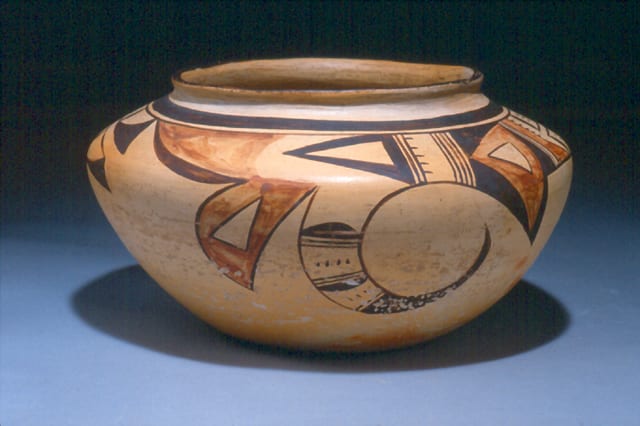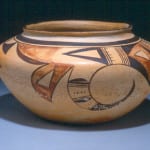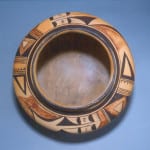“Jar, Hopi, First Mesa, Ariz. Sharp-shouldered bowl in yellow clay with black/brown and red (blotchy) painting of a Sikyatki revival bird motif. Unsigned. It may be the work of Zella Cheeda, but I cannot be sure. Ca. 1920-1940. Spalling on one side.” [Comments by Rick Dillingham, on file.] Based on Wyckoff’s typology (below) I would date this bowl as 1920-1930.
Lydia Wyckoff (1983) defines two types of Sikyatki Revival Polychrome: “Style A” and “Style B.” Style A from about 1903 to about 1930 and Style B from about 1903 or 1910 to the present. 1993-06 is apparently Style A: “the black and red colors used for the designs are made with the same pigments used in Polacca Polychrome. They are distinguishable from both prehistoric Sikyatki and other (Style B) Sikyatki Revival wares because the red and black are more ‘dense’ and the red is ‘muddy’…(T)his variety of pottery persisted until 1927. It is likely, in fact, that it persisted at least until 1930, when it came under attack from the Museum of Northern Arizona.” Wyckoff then quotes a Colton of the MNA who writes that, after a 1929 MNA survey, “steps were taken to check further deterioration” in Hopi pottery, primarily by establishing the Craftsmen Exhibition and sale.
The standards established by MNA were apparently designed to promote Style B criteria and discourage Style A Revival pottery: the surface finish for the pots in the MNA Exhibit were required to be “perfectly smooth and glossy” with a “consistently good black color” and a red that did “not look splotchy” and was not “a muddy brown instead of red” (Wyckoff, 1983:73-74). The dull, non-glossy surface of 1993-06 and its dense black and “splotchy” red paint clearly make it a Style A pot, the sort that the MNA promotion efforts replaced with the finer and more- polished Style B. See Wyckoff, (1983:80) for a clear illustration of the difference between Style A and B. I don’t think there is any real basis for attributing pot 1993-06 to Zella Cheeda, but 2004-04 was made by her.



